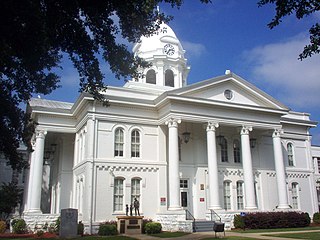
Colbert County is a county located in the northwestern part of the U.S. state of Alabama. As of the 2020 census the county's population was 57,227. The county seat is Tuscumbia. The largest city is Muscle Shoals.

Lauderdale County is a county located in the northwestern corner of the U.S. state of Alabama. At the 2020 census the population was 93,564. Its county seat is Florence. Its name is in honor of Colonel James Lauderdale, of Tennessee. Lauderdale is part of the Florence-Muscle Shoals, AL Metropolitan Statistical Area, also known as "The Shoals".

Muscle Shoals is the largest city in Colbert County, Alabama. It is located on the left bank of the Tennessee River in the northern part of the state and, as of the 2010 census, its population was 13,146. The estimated population in 2019 was 14,575.

Florence is a city in, and the county seat of, Lauderdale County, Alabama, United States, in the state's northwestern corner. It is situated along the Tennessee River and is home to the University of North Alabama.

Courtland is a town in Lawrence County, Alabama, United States, and is included in the Decatur Metropolitan Area, as well as the Huntsville-Decatur Combined Statistical Area. The population was 609 at the 2010 census, down from 769 in 2000.
Glencoe was a place name used by Scottish immigrants to name several places in the world. It may also refer to:

Alex Haley's Queen is a 1993 American television miniseries that aired in three installments on February 14, 16, and 18 on CBS. The miniseries is an adaptation of the 1993 novel Queen: The Story of an American Family, by Alex Haley and David Stevens. The novel is based on the life of Queen Jackson Haley, Haley's paternal grandmother. Alex Haley died in February 1992 before completing the novel. It was later finished by David Stevens and published in 1993. Stevens also wrote the screenplay for the miniseries.

Glencoe (1831–1857) was a British bred Thoroughbred racehorse, who won the 2,000 Guineas Stakes and the Ascot Gold Cup. He was one of the earliest Thoroughbred stallions imported into the United States and was a top broodmare sire there. Several outstanding sons of Lexington were out of Glencoe mares, including Asteroid, Kentucky and Norfolk.
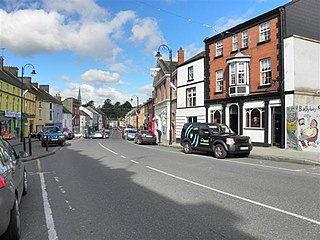
Ballybay is a town and civil parish in County Monaghan, Ireland. The town is centred on the crossroads of the R183 and R162 regional roads.
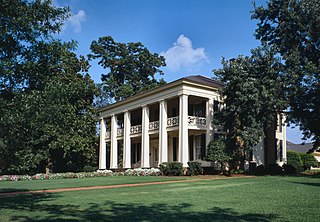
Arlington Antebellum Home & Gardens, or Arlington Historic House, is a former plantation and 6 acres (24,000 m2) of landscaped gardens near downtown Birmingham, Alabama. The two-story frame structure was built by enslaved people between 1845–50. Its style is antebellum-era Greek Revival architecture. The house serves as a decorative arts museum, featuring a collection of 19th-century furniture, textiles, silver, and paintings. The garden features a restored garden room that is used for special events. The house was added to the National Register of Historic Places on December 2, 1970, as Arlington, and has also been known as the Mudd-Munger House.

Wilson Dam is a dam on the Tennessee River between Lauderdale and Colbert counties in Alabama. Completed in 1924 by the United States Army Corps of Engineers, it impounds Wilson Lake, and is one of nine Tennessee Valley Authority (TVA) dams on the Tennessee River. It was declared a National Historic Landmark on November 13, 1966, for its role as the first dam to come under the TVA's administration. The dam is named for Woodrow Wilson.

Muscle Shoals Sound Studio is an American recording studio in Sheffield, Alabama, formed in 1969 by four session musicians known as The Muscle Shoals Rhythm Section. They had left nearby FAME Studios in Muscle Shoals to create their own recording facility.

Coby Hall is an antebellum Georgian Revival former residence in Florence, Alabama, that now serves as a learning and cultural center for the University of North Alabama.

Dry Fork Plantation, also known as James Asbury Tait House, is a historic plantation house in Coy, Alabama. The two-story wood-frame house was built between 1832 and 1834 in a vernacular interpretation of Federal style architecture. It was built for James Asbury Tait by two enslaved African Americans, Hezekiah and Elijah. The floor plan is centered on a hall that separates four rooms, two on each side, on both floors. Tait recorded in his daybook that the house required 25,000 board feet (59 m3) of lumber, the roof was covered with 6,000 wooden shingles, and the chimneys and foundation required 12,000 bricks, made from clay on the plantation. Dry Fork is one of the oldest houses still standing in Wilcox County and remains in the Tait family. It was added to the National Register of Historic Places on February 26, 1999, with the name of Dry Forks Plantation.

State Route 133 (SR 133) is a 16.976-mile-long (27.320 km) mostly multi-lane state highway and is a primary artery through the Florence–Muscle Shoals metropolitan area in the northwestern part of the U.S. state of Alabama.

William Nichols, Sr. was an English-born architect who emigrated to the United States and became most famous for his early Neoclassical-style buildings in the American South. He designed statehouses for North Carolina, Alabama and Mississippi.
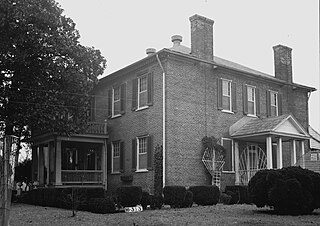
Sweetwater Mansion, located in Florence, Alabama, is a plantation house designed by General John Brahan of the Alabama Militia.

Umbria Plantation, also known as the Samuel Pickens Plantation, was a historic cotton plantation and Greek Revival-style plantation house near what is now Sawyerville, Alabama. The plantation was established by Samuel Pickens, the younger brother of Alabama's third governor, Israel Pickens. The house was an unusual example of a raised basement plantation house built on a U-shaped plan. It was recorded by the Historic American Buildings Survey during the 1930s. It was destroyed in a fire in the early 1970s.
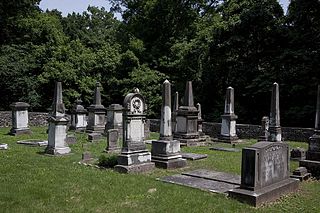
Forks of Cypress Cemetery is a historic cemetery near Florence, Alabama. The cemetery contains the graves of Forks of Cypress owner James Jackson, several members of his family, and numerous slaves who worked on the plantation. Jackson, an immigrant from County Monaghan, Ireland, purchased the estate in 1818 and built the main house in 1830. The cemetery was established soon after the estate; the oldest interment, dating from 1819, is William Augustus Moore, a relative of Jackson's wife, Sally.
The Florence Plantation was a former cotton plantation and is a historic site, located in the community of Harwood in Chicot County, Arkansas.





















